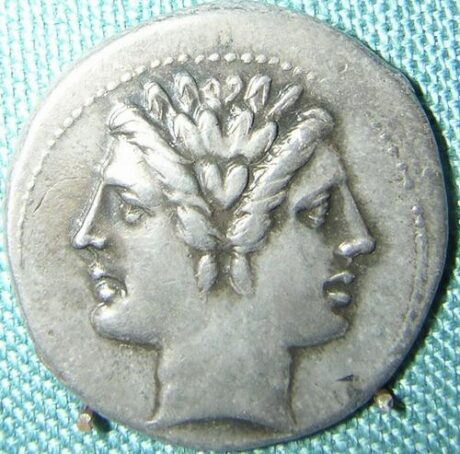The celebration of the new year is one of the oldest holidays. Many believe it was first observed in ancient Babylon about 4000 years ago it marked the first New Moon after the Vernal Equinox. The Babylonian new year celebration lasted for eleven days.
In 45 B.C., New Year’s Day is celebrated on January 1 for the first time in history as the Julian calendar takes effect. Soon after becoming Roman dictator, Julius Caesar decided that the traditional Roman calendar was in dire need of reform.
The month of January was named for their god, Janus, who is pictured with two heads. One looks forward, the other back, symbolizing a break between the old and new.
Julius Caesar thought it would be appropriate for January, Janus’s namesake month, to be the doorway to a new year, and when he created the Julian calendar, he made January 1 the first day of the year (this also put the calendar year in line with the consular year, as new consuls also took office that day).
How did New Years Day move from the summer to the winter?
Originally, January 1 was the date of the new year in the Julian calendar, but after the fall of the Roman Empire, the date gradually changed in various parts of Europe to March 25, to conform with Christian festival of the Annunciation. England adopted March 25th as New Year’s day in the twelfth century.
The Julian Calendar was replaced by the Gregorian Calendar, changing the formula for calculating leap years in accordance with a 1750 act of Parliament, England and its colonies changed calendars in 1752 changing the formula for calculating leap years.
The most surreal part of implementing the new calendar came in October 1582, when 10 days were dropped from the calendar to bring the vernal equinox from March 11 back to March 21. So, in countries that adopted the new calendar, the Feast of St. Francis of Assisi on October 4, 1582, was directly followed by October 15.
The beginning of the legal new year was moved from March 25 back to January 1.
The ancient Romans originally had ten months, with the year starting in March, named for Mars the God of War. When they realized that there were actually twelve lunar cycles in a year, they added two months: January and February. The Romans had earlier made January 1st the first day of their civic year.
The Gregorian calendar we use today is a small modification of the Julian calendar. That calendar started the new year on March 1st, and it represented the beginning of the agricultural cycle, when farmers first started bringing produce to markets.
What is the Julian calendar 2021?
The Julian calendar is still used in parts of the Eastern Orthodox Church and in parts of Oriental Orthodoxy as well as by the Berbers. The Julian calendar has two types of years: a normal year of 365 days and a leap year of 366 days. Today is Julian calendar date December 19,2021. For example, these cultures would celebrate Christmas on January 7, 2022 rather than December 25, 2021.
Modern day New Years Day is once again celebrated on January 1st
Not all countries celebrate New Year at the same time, nor in the same way. This is because people in different parts of the world use different calendars. Long ago, people divided time into days, months, and years. Some calendars are based on the movement of the moon, others are based on the position of the sun, while others are based on both the sun and the moon. All over the world, there are special beliefs about New Year.
Greek Culture
The Greeks paraded a baby in a basket to represent the spirit of fertility. Christians adopted this symbol as the birth of the baby Jesus and continued what started as a pagan ritual.
Today, our New Year’s symbols are a newborn baby starting the next year and an old man winding up the last year.
The Jewish New Year is called Rosh Hashanah
It is a holy time when people reflect on the things done wrong in the past, with a promise to do better in the future. Religious services are held in synagogues, and an instrument called a Shofar, which is made from a ram’s horn is played. Children are given new clothes, and New Year loaves are baked and fruit is eaten to remind people of harvest time.
The Chinese New Year
It is celebrated some time between January 17 and February 19, at the time of the new moon, and it is called Yuan Tan. It is celebrated by Chinese people all over the world, and street parades are an exciting part of their New Year. At the Festival of Lanterns thousands of lanterns are used to light the way for the New Year. Tuesday, February 1 will be Chinese New Year 2022.
The Chinese people believe that there are evil spirits around at New Year, so they let off firecrackers to frighten the spirits away. Sometimes they seal their windows and doors with paper to keep the evil spirits out.
New Year Resolutions
The traditions of the season include the making of New Year’s resolutions. Making a resolutions to change some part of one’s life also dates back to the early Babylonians. What was a popular New Year’s resolution for the ancient Babylonians?
In 2000 B.C., the Babylonians celebrated the New Year during a 12-day festival called Akitu (starting with the vernal equinox). This was the start of the farming season to plant crops, crown their king, and make promises to pay their debts.
The origin of making New Year’s resolutions rests with the Babylonians, who reportedly made promises to the gods in hopes they’d earn good favor in the coming year.
The most popular New Year’s resolutions are about self improvement (living healthier 23% of people, getting happy 21%, losing weight 20%, exercising 7%, stopping smoking 5%, reducing drinking 2%). In addition, people resolve to meet career or job goals (16%) and improve their relationships (11%). Today most people promise to lose weight or quit smoking.
New Year foods that are round in shape also thought to bring luck
Many cultures believe that anything in the shape of a ring is good luck, because it symbolizes “coming full circle,” completing a year’s cycle. Some put coins in black-eyed peas and the person who gets the coin in their meal will be prosperous in the coming year.
The origin is to eat black eyed peas, greens, and cornbread together on New Year’s Day.
The peas are supposed to bring pennies, greens like cabbage, collard and kale which resemble paper money bring dollars, and cornbread brings gold. Eating greens is believed to bring about greater financial prosperity.
Pork symbolizes abundance, plenty of food, and the fat of the land (think pork barrel legislation). It is said that eating pork brings good luck and progress, mainly because pigs are known to root forward.
For those that cannot eat pork, fish is considered to be one of the luckiest foods for New Year. It is believed in many cultures that the silvery and shiny fish brings good luck, wealth and prosperity. Fish are known to lay many eggs which signify abundance and so, you may find many people enjoy seafood dishes during New Year.
Bottom-feeding fish such as halibut, catfish, lobster, and shrimp are thought to be bad luck if eaten on New Year’s Day.
One fish that many people label as a bottom feeder is Tilapia—but that’s not strictly true. In the wild, Tilapia usually eat around the mid-level of the water, although they will go to the bottom for food if they can’t find suitable food anywhere else. When they can get it, they opt for a diet of algae and lake plants.
Are salmon considered bottom feeders? No, they are not. Bottom feeders are animals that feed near the bottom of water. Fish that are bottom feeders include groundfish, halibut, cod, bass, grouper, carps and bream. Salmon, on the other hand do not feed near the bottom of the ocean or lake
A great meal this year suggested would be salmon or tilapia served with lentils and a side of greens.
Avoid eating bottom-feeding fish on the first day of the year so the rest of the year you will be flying high!
Our ancestors thought that one could affect the luck they would have throughout the coming year by what they did or ate on the first day of the year.
It has become common for folks to celebrate the first few minutes of a brand new year in the company of family and friends.
New Year’s Day Celebration Origins and Cultural Traditions
January 1, 2022 by







